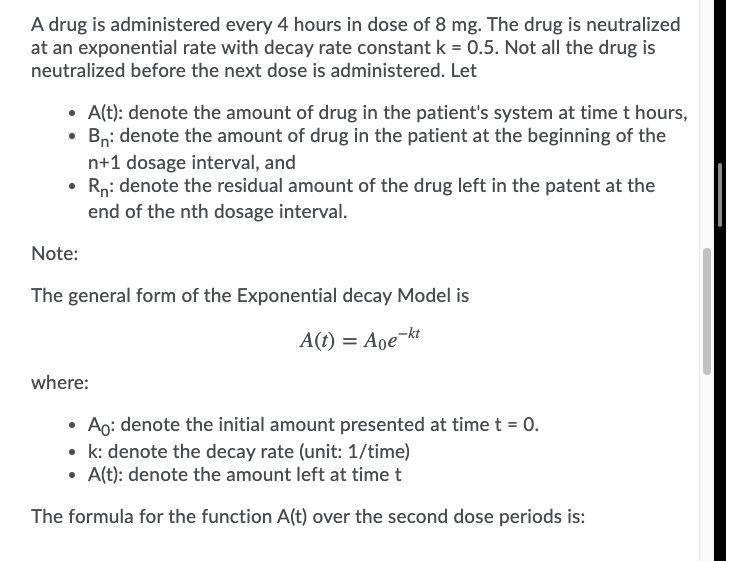A drug is administered every 4 hours in dose of 8 mg. The drug is neutralized at an exponential rate with decay rate constant k = 0.5. Not all the drug is neutralized before the next dose is administered. Let • A(t): denote the amount of drug in the patient's system at time t hours, • Bni denote the amount of drug in the patient at the beginning of the n+1 dosage interval, and • Rn: denote the residual amount of the drug left in the patent at the end of the nth dosage interval. Note: The general form of the Exponential decay Model A(t) = Aoe¬kt where: • Ao: denote the initial amount presented at time t = 0. • k: denote the decay rate (unit: 1/time) • A(t): denote the amount left at time t The formula for the function A(t) over the second dose periods is:
A drug is administered every 4 hours in dose of 8 mg. The drug is neutralized at an exponential rate with decay rate constant k = 0.5. Not all the drug is neutralized before the next dose is administered. Let • A(t): denote the amount of drug in the patient's system at time t hours, • Bni denote the amount of drug in the patient at the beginning of the n+1 dosage interval, and • Rn: denote the residual amount of the drug left in the patent at the end of the nth dosage interval. Note: The general form of the Exponential decay Model A(t) = Aoe¬kt where: • Ao: denote the initial amount presented at time t = 0. • k: denote the decay rate (unit: 1/time) • A(t): denote the amount left at time t The formula for the function A(t) over the second dose periods is:
Linear Algebra: A Modern Introduction
4th Edition
ISBN:9781285463247
Author:David Poole
Publisher:David Poole
Chapter6: Vector Spaces
Section6.7: Applications
Problem 16EQ
Related questions
Question

Transcribed Image Text:A drug is administered every 4 hours in dose of 8 mg. The drug is neutralized
at an exponential rate with decay rate constant k = 0.5. Not all the drug is
neutralized before the next dose is administered. Let
• A(t): denote the amount of drug in the patient's system at time t hours,
• Bni denote the amount of drug in the patient at the beginning of the
n+1 dosage interval, and
• Rn: denote the residual amount of the drug left in the patent at the
end of the nth dosage interval.
Note:
The general form of the Exponential decay Model
A(t) = Aoe¬kt
where:
• Ao: denote the initial amount presented at time t = 0.
• k: denote the decay rate (unit: 1/time)
• A(t): denote the amount left at time t
The formula for the function A(t) over the second dose periods is:
Expert Solution
This question has been solved!
Explore an expertly crafted, step-by-step solution for a thorough understanding of key concepts.
This is a popular solution!
Trending now
This is a popular solution!
Step by step
Solved in 3 steps with 3 images

Recommended textbooks for you

Linear Algebra: A Modern Introduction
Algebra
ISBN:
9781285463247
Author:
David Poole
Publisher:
Cengage Learning


Algebra & Trigonometry with Analytic Geometry
Algebra
ISBN:
9781133382119
Author:
Swokowski
Publisher:
Cengage

Linear Algebra: A Modern Introduction
Algebra
ISBN:
9781285463247
Author:
David Poole
Publisher:
Cengage Learning


Algebra & Trigonometry with Analytic Geometry
Algebra
ISBN:
9781133382119
Author:
Swokowski
Publisher:
Cengage